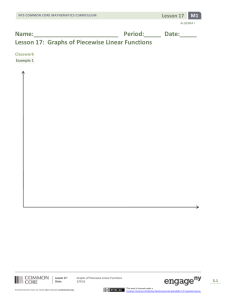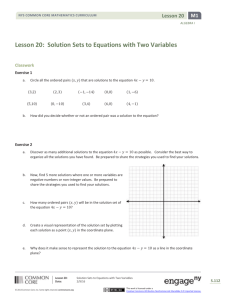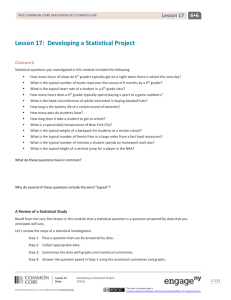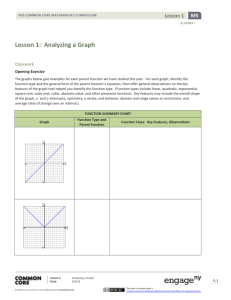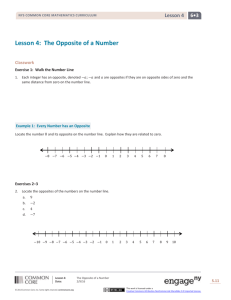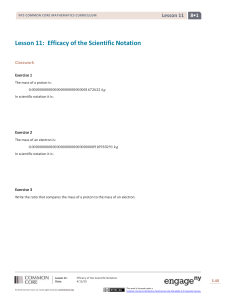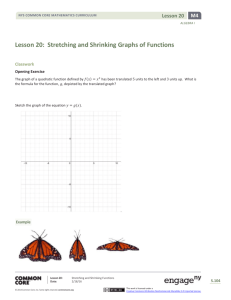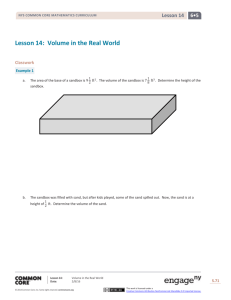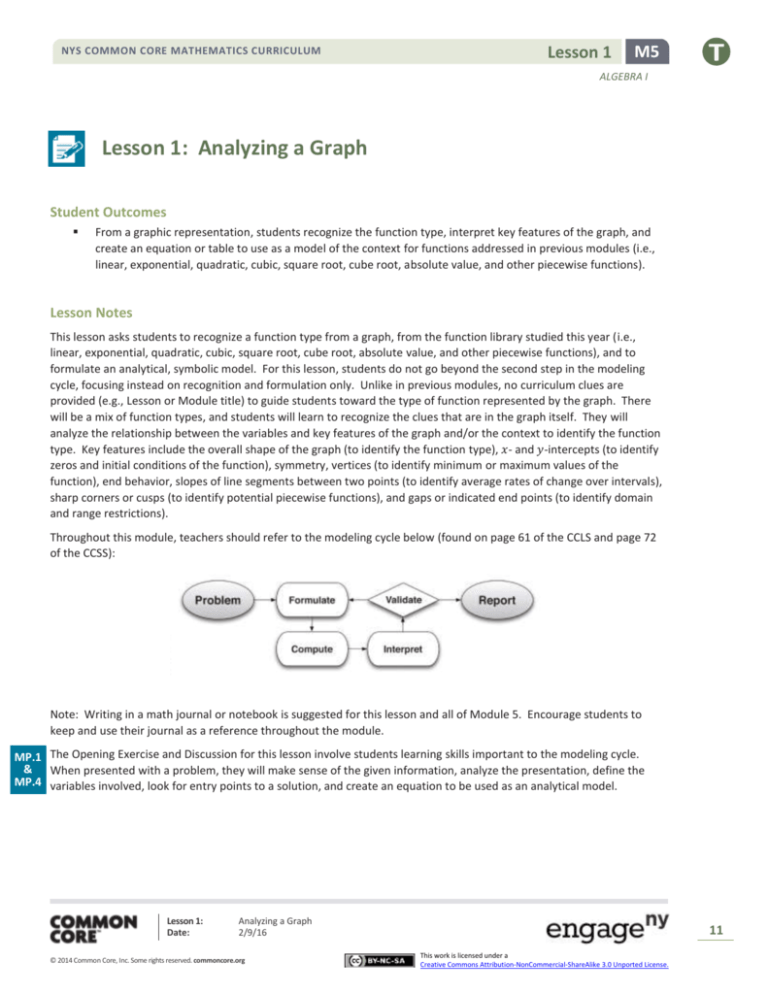
NYS COMMON CORE MATHEMATICS CURRICULUM
Lesson 1
M5
ALGEBRA I
Lesson 1: Analyzing a Graph
Student Outcomes
From a graphic representation, students recognize the function type, interpret key features of the graph, and
create an equation or table to use as a model of the context for functions addressed in previous modules (i.e.,
linear, exponential, quadratic, cubic, square root, cube root, absolute value, and other piecewise functions).
Lesson Notes
This lesson asks students to recognize a function type from a graph, from the function library studied this year (i.e.,
linear, exponential, quadratic, cubic, square root, cube root, absolute value, and other piecewise functions), and to
formulate an analytical, symbolic model. For this lesson, students do not go beyond the second step in the modeling
cycle, focusing instead on recognition and formulation only. Unlike in previous modules, no curriculum clues are
provided (e.g., Lesson or Module title) to guide students toward the type of function represented by the graph. There
will be a mix of function types, and students will learn to recognize the clues that are in the graph itself. They will
analyze the relationship between the variables and key features of the graph and/or the context to identify the function
type. Key features include the overall shape of the graph (to identify the function type), 𝑥- and 𝑦-intercepts (to identify
zeros and initial conditions of the function), symmetry, vertices (to identify minimum or maximum values of the
function), end behavior, slopes of line segments between two points (to identify average rates of change over intervals),
sharp corners or cusps (to identify potential piecewise functions), and gaps or indicated end points (to identify domain
and range restrictions).
Throughout this module, teachers should refer to the modeling cycle below (found on page 61 of the CCLS and page 72
of the CCSS):
Note: Writing in a math journal or notebook is suggested for this lesson and all of Module 5. Encourage students to
keep and use their journal as a reference throughout the module.
MP.1 The Opening Exercise and Discussion for this lesson involve students learning skills important to the modeling cycle.
& When presented with a problem, they will make sense of the given information, analyze the presentation, define the
MP.4 variables involved, look for entry points to a solution, and create an equation to be used as an analytical model.
Lesson 1:
Date:
Analyzing a Graph
2/9/16
© 2014 Common Core, Inc. Some rights reserved. commoncore.org
11
This work is licensed under a
Creative Commons Attribution-NonCommercial-ShareAlike 3.0 Unported License.
M5
Lesson 1
NYS COMMON CORE MATHEMATICS CURRICULUM
ALGEBRA I
Classwork
Opening Exercise (8 minutes)
The discussion following the Opening Exercise assumes students have already filled out the Function Summary Chart.
Unless you have time to allow students to work on the chart during class, it would be best to assign the chart as the
Problem Set the night before this lesson so that this discussion can be a discussion of the students’ responses. If time
allows, you might use two days for this lesson, with the first day spent discussing the Function Summary Chart and the
second day starting with Example 1.
Have students work independently, but allow them time to
confer with a partner or small group as they fill in the chart
below. Remember that students studied many of these
functions earlier in the year and their memories may need
to be refreshed. As needed, remind them of the key
features that could provide evidence for the function types.
Try to keep this exercise to about one minute per graph.
You might even set a timer and have students come up
with as many features as possible in one minute. Allow
them to include the table in their journals or notebooks as
a reference and to add to it as they work through this
lesson and subsequent lessons in this module. The
descriptions provided in the third column of the chart are
not meant to be exhaustive. Students may have fewer or
more observations than the chart provides. Observations
may be related to the parent function but should also take
into account the key features of transformations of the
parent.
In the Function Summary Chart, and later in this module,
the cubic functions we are exploring are basic
transformations of the parent function only. We do not yet
delve into the study of the general cubic function. The
descriptions in the chart relate to features of a basic cubic
function and its transformations only, (i.e., vertical or
horizontal translation and/or vertical or horizontal scaling).
Scaffolding:
Using a visual journal of the function families will help
struggling students to conceptualize the various functions
in their growing library and to more readily recognize
those functions.
For accelerated students who may need a challenge, ask
them to explore cubic functions in factored form and
comment on the differences in the key features of those
graphs as compared to the basic parent cubic functions.
For example, explore the key features of this cubic graph:
𝑓(𝑥) = (𝑥 − 2)(𝑥 + 1)(𝑥 − 4).
y
5
x
-5
5
-5
Opening Exercise
The graphs below give examples for each parent function we have studied this year. For each graph, identify the function
type and the general form of the parent function’s equation; then offer general observations on the key features of the
graph that helped you identify the function type. (Function types include linear, quadratic, exponential, square root, cube
root, cubic, absolute value, and other piecewise functions. Key features may include the overall shape of the graph,
𝒙- and 𝒚-intercepts, symmetry, a vertex, end behavior, domain and range values or restrictions, and average rates of
change over an interval.)
Lesson 1:
Date:
Analyzing a Graph
2/9/16
© 2014 Common Core, Inc. Some rights reserved. commoncore.org
12
This work is licensed under a
Creative Commons Attribution-NonCommercial-ShareAlike 3.0 Unported License.
Lesson 1
NYS COMMON CORE MATHEMATICS CURRICULUM
M5
ALGEBRA I
Function Summary Chart
Function Type and
Parent Function
Graph
Function Clues: Key Features, Observations
Linear
𝒇(𝒙) = 𝒙
Absolute value
𝒇(𝒙) = |𝒙|
Exponential
𝒇(𝒙) = 𝒂𝒙
Lesson 1:
Date:
Overall shape is a straight line.
Generally, there is one intercept for each
axis, except in the case where the slope is 𝟎.
In this graph of the parent function, the 𝒙and 𝒚-intercept are the same point, (𝟎, 𝟎).
The average rate of change is the same for
every interval.
If a line is horizontal, it is still a function
(slope is 𝟎) but not if it is vertical.
There is no symmetry.
Overall shape is a V.
Has a vertex—minimum or maximum value
depending on the sign of the leading
coefficient.
The domain is all real numbers, and the
range will vary.
Average rates of change are constant for all
intervals with endpoints on the same side of
the vertex.
Either goes up or down to infinity.
Reflects across a line of symmetry at the
vertex.
May have one, two, or no 𝒙-intercepts and
always has one 𝒚-intercept.
This is actually a linear piecewise function.
Overall shape is a growth or decay function.
For the parent shown here (growth), as 𝒙
increases, 𝒚 increases more quickly; for
decay functions, as 𝒙 increases, 𝒚 decreases.
Domain: 𝒙 is all real numbers, the range
varies but is limited.
For this growth parent, 𝒚 is always greater
than 𝟎.
For the decay parent, 𝒚 is also always
greater than 𝟎.
For growth or decay functions with a vertical
shift, 𝒚 will be greater than the value of the
shift.
The parent growth or decay function has no
𝒙-intercepts (no zeros) and one 𝒚-intercept,
but those with a vertical shift down will have
one 𝒙-intercept and one 𝒚-intercept, and
those with a vertical shift up will have no 𝒙intercepts and one 𝒚-intercept.
There is no minimum or maximum value.
Even though there will be range restrictions
for growth, the average rate of change
increases as the intervals move to the right;
the average rate of change can never be 𝟎.
There is no symmetry.
Analyzing a Graph
2/9/16
© 2014 Common Core, Inc. Some rights reserved. commoncore.org
13
This work is licensed under a
Creative Commons Attribution-NonCommercial-ShareAlike 3.0 Unported License.
Lesson 1
NYS COMMON CORE MATHEMATICS CURRICULUM
M5
ALGEBRA I
Quadratic
𝒇(𝒙) = 𝒙𝟐
Square root
𝒇(𝒙) = √𝒙
Cubic
𝒇(𝒙) = 𝒙𝟑
Cube root
𝒇(𝒙) = 𝟑√𝒙
Lesson 1:
Date:
Overall shape is a U.
Has a vertex—minimum or maximum value
depending on the sign of the leading
coefficient.
Average rates of change are different for
every interval with endpoints on the same
side of the vertex.
Symmetry across a line of symmetry—for
this parent function it is the 𝒚-axis.
There may be none, one, or two 𝒙-intercepts,
depending on the position of the graph in
relation to the 𝒙-axis.
There is always one 𝒚-intercept.
Reflection and rotation of part of the
quadratic function; no negative values for 𝒙
or 𝒚.
Related to the graph of 𝒙 = 𝒚𝟐 but only
allows non-negative values.
There may be none or one 𝒙- and 𝒚intercept, depending on the position of the
graph in relation to the axes.
These graphs always have an endpoint,
which can be considered a minimum or
maximum value of the function.
There are domain and range restrictions
depending on the position of the graph on
the coordinate plane.
There is no symmetry.
The overall shape of the parent function is a
curve that rises gently and then appears to
level off then begin to rise again.
The parent function will have one 𝒙- and one
𝒚-intercept—in this parent graph both are
the point (𝟎, 𝟎).
The parent graph skims across either side of
the 𝒙-axis where it crosses.
If the leading coefficient is negative, the
curve will reflect across the 𝒚-axis.
There is no symmetry.
Overall shape is a rotation and reflection of
the cubic (an S curve).
Domain: 𝒙 is all real numbers.
𝒙 and 𝒚 have the same sign.
Will have one 𝒙- and one 𝒚-intercept.
For the parent graph, the 𝒙-and 𝒚-intercepts
happen to be the same point (𝟎, 𝟎).
Analyzing a Graph
2/9/16
© 2014 Common Core, Inc. Some rights reserved. commoncore.org
14
This work is licensed under a
Creative Commons Attribution-NonCommercial-ShareAlike 3.0 Unported License.
Lesson 1
NYS COMMON CORE MATHEMATICS CURRICULUM
M5
ALGEBRA I
Piecewise defined
(linear)
𝒇(𝒙)
𝒎 𝒙 + 𝒃𝟏 , 𝒙 ≤ 𝒂
}
={ 𝟏
𝒎𝟐 𝒙 + 𝒃𝟐 , 𝒙 > 𝒂
Overall shape is sections (intervals) of
different graphs—this example shows a
piecewise linear function
It has a corner or cusp where the two pieces
of the graph meet
This example is not absolute value because it
is not a reflection
Domain and range depend on the definition
of the function
Note: The general form of the equations might be
different and still be correct.
Hold a short discussion about the charts in the Opening Exercise. Have students refer to their charts to answer the
questions below and add to their charts as they gain insights from the discussion. Let them know that this chart will be
their reference tool as they work on the lessons in this module. Encourage students to fill it out as completely as
possible and to add relevant notes to their math notebooks or journals.
When presented with a graph, what is the most important key feature that will help you recognize the type of
function it represents?
Which graphs have a minimum or maximum value?
Absolute value and quadratic functions
Which of the parent functions are transformations of other parent functions?
Square root, absolute value, exponential, quadratic, and sometimes piecewise functions
Which have lines of symmetry?
Square root (no negative numbers allowed under the radical) and sometimes piecewise (with defined
restrictions in the domains)
Which will have restrictions on their range?
Quadratic, absolute value, square root, and some piecewise functions
Which have domain restrictions? What are those restrictions?
Overall shape is the most readily apparent feature of each function.
Cubic and cube root functions, quadratic and square root functions
How are you able to recognize the function if the graph is a transformation of the parent function?
The overall shape will be the same, even though sometimes it is shifted (vertically or horizontally),
stretched or shrunk, and/or reflected.
Example 1 (8 minutes)
Project the graph that follows onto the board or screen. Make sure it is enlarged so that the coordinates are visible.
Have students look closely at the piecewise function and talk them through the questions. Leave the graph on the
screen while they work on Exercise 1, but discourage them from looking ahead.
Piecewise defined functions have the most variety of all the graphs you have studied this year. Let’s look more
closely at the piecewise function in your chart in the Opening Exercise.
Lesson 1:
Date:
Analyzing a Graph
2/9/16
© 2014 Common Core, Inc. Some rights reserved. commoncore.org
15
This work is licensed under a
Creative Commons Attribution-NonCommercial-ShareAlike 3.0 Unported License.
Lesson 1
NYS COMMON CORE MATHEMATICS CURRICULUM
M5
ALGEBRA I
Example 1
Earnings (dollars)
Eduardo has a summer job that pays him a certain rate for the first 𝟒𝟎 hours each week and time-and-a-half for any
overtime hours. The graph below shows how much money he earns as a function of the hours he works in one week.
Time (hours)
Scaffolding:
Start by asking students to consider the function equation for this graph, and
ask them to justify their choices. If students are unable to come up with
viable options, you might use this scaffolding suggestion. Otherwise skip to
the questions that follow, and use them to guide the discussion. Try to use
as little scaffolding as possible in this section so that students have an
experience closer to a true modeling situation.
Right now we are in the formulate stage of the modeling cycle. This
means we are starting with a problem and selecting a model
(symbolic, analytical, tabular, and/or graphic) that can represent the
relationship between the variables used in the context. What are
the variables in this problem? What are the units?
Time worked (in hours); earnings (in dollars)
We have identified the variables. Now let’s think about how the
problem defines the relationship between the variables.
The number of dollars earned is dependent on the number
of hours worked. The relationship is piecewise linear
because the average rate of change is constant for each of
the intervals (pieces), as depicted in the graph.
Lesson 1:
Date:
If students are unable to recognize the
correct function for the piecewise graph,
write the four functions shown below on the
screen or board near the graph, and have
the students consider each for a few
seconds. Then, ask the questions that follow
to guide the discussion.
Which of these general functions below
could be used to represent the graph
above? How did you choose?
A: 𝑛(𝑥) = 𝑎|𝑥 − ℎ| + 𝑘
B: 𝑣(𝑥) = 𝑎𝑥 2 + 𝑏𝑥 + 𝑐
𝑚 𝑥 + 𝑏1 , if 𝑥 ≤ 40
C: 𝑔(𝑥) = { 1
}
𝑚2 𝑥 + 𝑏2 , if 𝑥 > 40
D: 𝑧(𝑥) = 𝑚𝑥 + 𝑏
C: 𝑔(𝑥). The graph is a
piecewise function, so the only
function that could be correct is
a pair of expressions on different
intervals of the domain.
Analyzing a Graph
2/9/16
© 2014 Common Core, Inc. Some rights reserved. commoncore.org
16
This work is licensed under a
Creative Commons Attribution-NonCommercial-ShareAlike 3.0 Unported License.
Lesson 1
NYS COMMON CORE MATHEMATICS CURRICULUM
M5
ALGEBRA I
So what does this graph tell you about Eduardo’s pay for his summer job?
He has a constant pay rate up to 40 hours, and then the rate changes to a higher amount. (Students
may notice that his pay rate from 0 to 40 hours is $9, and from 40 hours on is $13.50.)
The graph shows us the relationship. In fact, it is an important part of the formulating step because it helps us
to better understand the relationship. Why would it be important to find the analytical representation of the
function as well?
The equation captures the essence of the relationship succinctly and allows us to find or estimate values
that are not shown on the graph.
How did you choose the function type? What were the clues in the graph?
Visually, the graph looks like two straight line segments stitched together. So, we can use a linear
function to model each straight-line segment. The presence of a sharp corner usually indicates a need
for a piecewise defined function.
There are four points given on the graph. Is that enough to determine the function?
In this case, yes. Each linear piece of the function has two points, so we could determine the equation
for each.
What do you notice about the pieces of the graph?
The second piece is steeper than the first; they meet where 𝑥 = 40; the first goes through the origin;
there are two known points for each piece.
Exercises (18 minutes)
Have students use the graph in Example 1 to find the function that represents the graph. They should work in pairs or
small groups. Circulate throughout the room to make sure all students are able to create a linear equation of each piece.
Then, debrief before moving on to the remaining exercises.
Exercises
1.
Write the function in analytical (symbolic) form for the graph in Example 1.
a.
What is the equation for the first piece of the graph?
The two points we know are (𝟎, 𝟎) and (𝟐𝟐, 𝟏𝟗𝟖). The slope of the line is 𝟗 (or $𝟗/hour), and the equation is
𝒇(𝒙) = 𝟗𝒙.
b.
What is the equation for the second piece of the graph?
The second piece has the points (𝟔𝟎, 𝟔𝟑𝟎) and (𝟕𝟎, 𝟕𝟔𝟓). The slope of the line is 𝟏𝟑. 𝟓 (or $𝟏𝟑. 𝟓𝟎/hour),
and the equation in point-slope form would be either 𝒚 − 𝟔𝟑𝟎 = 𝟏𝟑. 𝟓(𝒙 − 𝟔𝟎) or
𝒚 − 𝟕𝟔𝟓 = 𝟏𝟑. 𝟓(𝒙 − 𝟕𝟎), with both leading to the function, 𝒇(𝒙) = 𝟏𝟑. 𝟓𝒙 − 𝟏𝟖𝟎
c.
What are the domain restrictions for the context?
The graph is restricted to one week of work with the first piece starting at 𝒙 = 𝟎 and stopping at 𝒙 = 𝟒𝟎. The
second piece applies to 𝒙-values greater than 𝟒𝟎. Since there are 𝟏𝟔𝟖 hours in one week, the absolute upper
limit should be 𝟏𝟔𝟖 hours. However, no one can work non-stop, so setting 𝟖𝟎 hours as an upper limit would
be reasonable. Beyond 𝟏𝟔𝟖 hours, Eduardo would be starting the next week and would start over with
$𝟗/hour for the next 𝟒𝟎 hours.
Lesson 1:
Date:
Analyzing a Graph
2/9/16
© 2014 Common Core, Inc. Some rights reserved. commoncore.org
17
This work is licensed under a
Creative Commons Attribution-NonCommercial-ShareAlike 3.0 Unported License.
Lesson 1
NYS COMMON CORE MATHEMATICS CURRICULUM
M5
ALGEBRA I
d.
Explain the domain in the context of the problem.
The first piece starts at 𝒙 = 𝟎 and stops at 𝒙 = 𝟒𝟎. The second piece starts 𝒂𝒕 𝒙 > 𝟒𝟎. From 𝟎 to 𝟒𝟎 hours
the rate is the same: $𝟗/hour. Then, the rate changes to $𝟏𝟑. 𝟓𝟎/hour at 𝒙 > 𝟒𝟎. After 𝟖𝟎 hours, it is
undefined since Eduardo would need to sleep.
Students may notice that the context may not be graphed as precisely as possible, since it is not known for sure whether
Eduardo will be paid for partial hours. However, this would typically be the case. With the use of a time clock, pay
would be to the nearest minute (e.g., for 30 minutes of work during the first 40 hours he would get $4.50.) This could
inspire a good discussion about precision in graphing and would show that your students are really thinking
mathematically. You may or may not decide to broach that subject depending on the needs of your students.
Before having students continue with the exercises, pose the following question.
Graphs are used to represent a function and to model a context. What would the advantage be to writing an
equation to model the situation too?
With a graph, you have to estimate values that are not integers. Having an equation allows you to
evaluate for any domain value and determine the exact value of the function. Additionally, with an
equation, you can more easily extend the function to larger domain and range values—even to those
that would be very difficult to capture in a physical graph. This feature is very useful, for example, in
making predictions about the future or extrapolations into the past based on existing graphs of recent
data.
Use the following exercises either as guided or group practice. For now, we are just building a knowledge base for
formulating an equation that matches a graphic model. Remember that in later lessons we will be applying the functions
from a context and taking the problems through the full modeling cycle. Remind students that using graphs often
requires estimation of values and that using transformations of the parent function can help us create the equation
more efficiently. If needed, offer students some hints and reminders for exponential and absolute value functions. If
time is short, select the 2 to 3 graphs below that are likely to prove most challenging for your students (maybe the
exponential and cubic or cube root), and assign the rest as part of the Problem Set.
Point out phenomena that occur in real-life situations are usually not as tidy as these examples. We are working on the
skills needed to formulate a model and, for the sake of practice, will begin with mathematical functions that are friendly
and not in a context. Later, we will use more complex and real situations.
For each graph below, use the questions and identified ordered pairs to help you formulate an equation to represent it.
2.
Function type: Exponential
Parent function: 𝒇(𝒙) = 𝒂𝒙
Transformations: It appears that the graph could be that of a
parent function because it passes through (𝟎, 𝟏), and the 𝒙-axis
is a horizontal asymptote.
Equation: The fact that the graph passes through the point
(𝟎, 𝟏) and the 𝒙-axis is a horizontal asymptote indicates there is
no stretch factor or translation.
Finding 𝒂 using (𝟏, 𝟑):
𝟑 = 𝒂𝟏
𝟑=𝒂
𝒇(𝒙) = 𝟑𝒙
Lesson 1:
Date:
Analyzing a Graph
2/9/16
© 2014 Common Core, Inc. Some rights reserved. commoncore.org
18
This work is licensed under a
Creative Commons Attribution-NonCommercial-ShareAlike 3.0 Unported License.
Lesson 1
NYS COMMON CORE MATHEMATICS CURRICULUM
M5
ALGEBRA I
3.
Function type: Square root
Parent function: 𝒇(𝒙) = √𝐱
Transformations: Appears to be a stretch
Equation: 𝒇(𝒙) = 𝒂√𝐱
Checking for stretch or shrink factor using (𝟒, 𝟒):
𝟒 = 𝒂√𝟒
𝟒 = 𝒂(𝟐)
𝟐=𝒂
Checking 𝒂 = 𝟐 with (𝟏, 𝟐):
𝟐 = 𝟐√𝟏
𝟐 = 𝟐 Yes.
𝒇(𝒙) = 𝟐√𝒙
Note: Students may need a hint for this parent
function since they have not worked much with
square root functions. Additionally, the stretch
factor could be inside or outside the radical. You
might ask students who finish early to try it both
ways and verify that the results are the same (you
could use 𝒇(𝒙) = 𝒂√𝒙 or 𝒇(𝒙) = √𝒃𝒙).
4.
Function type: Cubic
Parent function: 𝐟(𝐱) = 𝐱 𝟑
Transformations: Appears to be a vertical shift of 𝟐 with no
horizontal shift
Equation: 𝐟(𝐱) = 𝐚𝐱 𝟑 + 𝟐
Checking for stretch or shrink with (−𝟏, 𝟏):
𝟏 = 𝒂(−𝟏)𝟑 + 𝟐
𝟏 = 𝒂 (no stretch or shrink)
Checking with (𝟐, 𝟏𝟎):
𝟏𝟎 = (𝟐)𝟑 + 𝟐
𝟏𝟎 = 𝟖 + 𝟐
𝟏𝟎 = 𝟏𝟎 Yes.
𝒇(𝒙) = 𝒙𝟑 + 𝟐
5.
Function type: Cube root
𝟑
Parent function: 𝐟(𝐱) = √𝐱
Transformations: Appears to be a shift to the right of 𝟏
𝟑
Equation: 𝐟(𝐱) = 𝐚√𝐱 − 𝟏
Checking for possible stretch or shrink using (𝟗, 𝟐):
𝟑
𝟐 = 𝒂√𝟗 − 𝟏
𝟏 = 𝒂 (no stretch or shrink)
Now check (𝟎, −𝟏):
𝟑
−𝟏 = √𝟎 − 𝟏
−𝟏 = −𝟏 Yes.
𝟑
𝒇(𝒙) = √𝒙 − 𝟏
Lesson 1:
Date:
Analyzing a Graph
2/9/16
© 2014 Common Core, Inc. Some rights reserved. commoncore.org
19
This work is licensed under a
Creative Commons Attribution-NonCommercial-ShareAlike 3.0 Unported License.
Lesson 1
NYS COMMON CORE MATHEMATICS CURRICULUM
M5
ALGEBRA I
6.
Function type: Quadratic
Parent function: 𝐟(𝐱) = 𝐱 𝟐
Transformations: Shift up 𝟐 units and to the right 𝟏 unit
Equation: Using the vertex form with (𝟏, 𝟐):
𝒇(𝒙) = 𝒂(𝒙 − 𝟏)𝟐 + 𝟐
Finding the stretch or shrink factor using (𝟎, 𝟓):
𝟓 = 𝒂(𝟎 − 𝟏)𝟐 + 𝟐
𝟑 = 𝒂(𝟏)
𝒂=𝟑
Checking with (𝟐, 𝟓):
𝟓 = 𝟑(𝟐 − 𝟏)𝟐 + 𝟐
𝟑 = 𝟑(𝟐 − 𝟏)
𝟑 = 𝟑(𝟏) Yes. There is a stretch factor of 𝟑.
𝒇(𝒙) = 𝟑(𝒙 − 𝟏)𝟐 + 𝟐
Closing (3 minutes)
As a class, review the Lesson Summary below.
Lesson Summary
When given a context represented graphically, you must first:
Identify the variables in the problem (dependent and independent), and
Identify the relationship between the variables that are described in the graph or situation.
To come up with a modeling expression from a graph, you must recognize the type of function the graph
represents, observe key features of the graph (including restrictions on the domain), identify the
quantities and units involved, and create an equation to analyze the graphed function.
Identifying a parent function and thinking of the transformation of the parent function to the graph of
the function can help with creating the analytical representation of the function.
Exit Ticket (8 minutes)
Enlarging and displaying the graph for this Exit Ticket problem on the board or screen may be helpful and would be
important for students with visual impairments.
Lesson 1:
Date:
Analyzing a Graph
2/9/16
© 2014 Common Core, Inc. Some rights reserved. commoncore.org
20
This work is licensed under a
Creative Commons Attribution-NonCommercial-ShareAlike 3.0 Unported License.
Lesson 1
NYS COMMON CORE MATHEMATICS CURRICULUM
M5
ALGEBRA I
Name ___________________________________________________
Date____________________
Lesson 1: Analyzing a Graph
Exit Ticket
Read the problem description, and answer the questions below. Use a separate piece of paper if needed.
A library posted a graph in its display case to illustrate the relationship between the fee for any given late day for a
borrowed book and the total number of days the book is overdue. The graph, shown below, includes a few data points
for reference. Rikki has forgotten this policy and wants to know what her fine would be for a given number of late days.
The ordered pairs on the graph are (1, 0.1), (10, 1), (11, 1.5), and (14, 3).
1.
What type of function is this?
2.
What is the general form of the parent function(s) of this
graph?
3.
What equations would you expect to use to model this
context?
4.
Describe verbally what this graph is telling you about the library fees.
Lesson 1:
Date:
Analyzing a Graph
2/9/16
© 2014 Common Core, Inc. Some rights reserved. commoncore.org
21
This work is licensed under a
Creative Commons Attribution-NonCommercial-ShareAlike 3.0 Unported License.
NYS COMMON CORE MATHEMATICS CURRICULUM
Lesson 1
M5
ALGEBRA I
5.
Compare the advantages and disadvantages of the graph versus the equation as a model for this relationship. What
would be the advantage of using a verbal description in this context? How might you use a table of values?
6.
What suggestions would you make to the library for how it could better share this information with its customers?
Comment on the accuracy and helpfulness of this graph.
Lesson 1:
Date:
Analyzing a Graph
2/9/16
© 2014 Common Core, Inc. Some rights reserved. commoncore.org
22
This work is licensed under a
Creative Commons Attribution-NonCommercial-ShareAlike 3.0 Unported License.
Lesson 1
NYS COMMON CORE MATHEMATICS CURRICULUM
M5
ALGEBRA I
Exit Ticket Sample Solutions
Read the problem description, and answer the questions below. Use a separate piece of paper if needed.
A library posted a graph in its display case to illustrate the relationship between the fee for any given late day for a
borrowed book and the total number of days the book is overdue. The graph, shown below, includes a few data points
for reference. Rikki has forgotten this policy and wants to know what her fine would be for a given number of late days.
The ordered pairs on the graph are (𝟏, 𝟎. 𝟏), (𝟏𝟎, 𝟏), (𝟏𝟏, 𝟏. 𝟓), and (𝟏𝟒, 𝟑).
1.
What type of function is this?
Piecewise linear.
2.
What is the general form of the parent function(s) of this graph?
𝒇(𝒙) = {
3.
𝒎𝟏 𝒙 + 𝒃𝟏 , 𝒙 ≤ 𝒂
}
𝒎𝟐 𝒙 + 𝒃𝟐 , 𝒙 > 𝒂
What equations would you expect to use to model this context?
𝒇(𝒙) = {
𝟎. 𝟏𝒙,
𝒊𝒇 𝒙 ≤ 𝟏𝟎
𝟎. 𝟓(𝒙 − 𝟏𝟎) + 𝟏, 𝒊𝒇 𝒙 > 𝟏𝟎
Students may be more informal in their descriptions of the function equation and might choose to make the domain
restriction of the second piece inclusive rather than the first piece since both pieces are joined at the same point.
4.
Describe verbally what this graph is telling you about the library fees.
The overdue fee is a flat rate of $𝟎. 𝟏𝟎 per day for the first 𝟏𝟎 days and then increases to $𝟎. 𝟓𝟎 per day after
𝟏𝟎 days. The fee for each of the first 𝟏𝟎 days is $𝟎. 𝟏𝟎, so the fee for 𝟏𝟎 full days is $𝟎. 𝟏𝟎(𝟏𝟎) = $𝟏. 𝟎𝟎. Then, the
fee for 𝟏𝟏 full days of late fees is $𝟏. 𝟎𝟎 + $𝟎. 𝟓𝟎 = $𝟏. 𝟓𝟎, etc. (From then on, the fee increases to $𝟎. 𝟓𝟎 for each
additional day.)
5.
Compare the advantages and disadvantages of the graph versus the equation as a model for this relationship. What
is the advantage of using a verbal description in this context? How might you use a table of values?
Graphs are visual and allow us to see the general shape and direction of the function. However, equations allow us
to determine more exact values since graphs only allow for estimates for any non-integer values. The late-fee
scenario depends on integer number of days only; other scenarios may involve independent variables of non-integer
values (e.g., gallons of gasoline purchased). In this case, a table could be used to show the fee for each day but
could also show the accumulated fees for the total number of days. For example, for 𝟏𝟓 days the fees would be
$𝟏. 𝟎𝟎 for the first 𝟏𝟎 + $𝟐. 𝟓𝟎 for the next 𝟓, for a total of $𝟑. 𝟓𝟎.
6.
What suggestions would you make to the library about how it could better share this information with its
customers? Comment on the accuracy and helpfulness of this graph.
Rather than displaying the late fee system in a graph, a table showing the total fine for the number of days late
would be clearer. If a graph is preferred, it might be better to use a discrete graph, or even a step graph, since the
fees are not figured by the hour or minute but only by the full day. While the given graph shows the rate for each
day, most customers would rather know, at a glance, what they owe, in total, for their overdue books.
Lesson 1:
Date:
Analyzing a Graph
2/9/16
© 2014 Common Core, Inc. Some rights reserved. commoncore.org
23
This work is licensed under a
Creative Commons Attribution-NonCommercial-ShareAlike 3.0 Unported License.
Lesson 1
NYS COMMON CORE MATHEMATICS CURRICULUM
M5
ALGEBRA I
Problem Set Sample Solutions
This problem allows for more practice with writing quadratic equations from a graph. Suggest that students use the
vertex form for the equation, as it is the most efficient when the vertex is known. Remind them to always use a second
point to find the leading coefficient. (And it is nice to have a third method to check their work.)
During tryouts for the track team, Bob is running 𝟗𝟎-foot wind sprints by running from a starting line to the far wall
of the gym and back. At time 𝒕 = 𝟎, he is at the starting line and ready to accelerate toward the opposite wall. As 𝒕
approaches 𝟔 seconds, he must slow down, stop for just an instant to touch the wall, turn around, and sprint back to
the starting line. His distance, in feet, from the starting line with respect to the number of seconds that has passed
for one repetition is modeled by the graph below.
a.
What are the key features of this graph?
The graph appears to represent a quadratic function. The maximum
point is at (𝟔, 𝟗𝟎). The zeros are at (𝟎, 𝟎) and (𝟏𝟐, 𝟎).
b.
What are the units involved?
Distance is measured in feet and time in seconds.
c.
Distance from starting line (feet)
1.
(0, 0)
What is the parent function of this graph?
We will attempt to model the graph with a quadratic function. The
parent function could be 𝒇(𝒕) = 𝒕𝟐 .
d.
(12, 0)
Time (seconds)
Were any transformations made to the parent functions to get this graph?
It has a negative leading coefficient, and it appears to shift up 𝟗𝟎 units and to the right 𝟔 units.
e.
What general analytical representation would you expect to model this context?
𝒇(𝒕) = 𝒂(𝒕 − 𝒉)𝟐 + 𝒌
f.
What do you already know about the parameters of the equation?
𝒂 < 𝟎, 𝒉 = 𝟔, 𝒌 = 𝟗𝟎
g.
Use the ordered pairs you know to replace the parameters in the general form of your equation with
constants so that the equation will model this context. Check your answer using the graph.
To find 𝒂, substitute (𝟎, 𝟎) for (𝒙, 𝒚) and (𝟔, 𝟗𝟎) for (𝒉, 𝒌):
𝟎 = 𝒂(𝟎 − 𝟔)𝟐 + 𝟗𝟎
−𝟗𝟎 = 𝒂(𝟑𝟔)
𝟗𝟎
𝒂=−
= −𝟐. 𝟓
𝟑𝟔
𝒇(𝒕) = −𝟐. 𝟓(𝒕 − 𝟔)𝟐 + 𝟗𝟎
Now check it with (𝟏𝟐, 𝟎):
𝟎 = −𝟐. 𝟓(𝟏𝟐 − 𝟔)𝟐 + 𝟗𝟎
−𝟗𝟎 = −𝟐. 𝟓(𝟑𝟔)
−𝟗𝟎 = −𝟗𝟎 Yes.
Lesson 1:
Date:
Analyzing a Graph
2/9/16
© 2014 Common Core, Inc. Some rights reserved. commoncore.org
24
This work is licensed under a
Creative Commons Attribution-NonCommercial-ShareAlike 3.0 Unported License.
Lesson 1
NYS COMMON CORE MATHEMATICS CURRICULUM
M5
ALGEBRA I
2.
Spencer and McKenna are on a long-distance bicycle ride. Spencer leaves one hour before McKenna. The graph
below shows each rider’s distance in miles from his or her house as a function of time since McKenna left on her
bicycle to catch up with Spencer. (Note: Parts (e), (f), and (g) are challenge problems.)
a.
Which function represents Spencer’s distance? Which function
represents McKenna’s distance? Explain your reasoning.
The function that starts at (𝟎, 𝟐𝟎) represents Spencer’s distance
since he had a 𝟏-hour head start. The function that starts at
(𝟎, 𝟎) represents McKenna’s distance since the graph is described
as showing distance since she started riding. That means at the
time she started riding (𝒕 = 𝟎 hours), her distance would need to
be 𝟎 miles.
b.
Estimate when McKenna catches up to Spencer. How far have they traveled at that point in time?
McKenna will catch up with Spencer after about 𝟑. 𝟐𝟓 hours. They will have traveled approximately 𝟒𝟏 miles
at that point.
c.
One rider is speeding up as time passes and the other one is slowing down. Which one is which, and how can
you tell from the graphs?
I know that Spencer is slowing down because his graph is getting less steep as time passes. I know that
McKenna is speeding up because her graph is getting steeper as time passes.
d.
According to the graphs, what type of function would best model each rider’s distance?
Spencer’s graph appears to be modeled by a square root function. McKenna’s graph appears to be quadratic.
e.
Create a function to model each rider’s distance as a function of the time since McKenna started riding her
bicycle. Use the data points labeled on the graph to create a precise model for each rider’s distance.
If Spencer started 𝟏 hour before McKenna, then (−𝟏, 𝟎) would be a point on his graph. Using a square root
function in the form 𝒇(𝒙) = 𝒌√𝒙 + 𝟏 would be appropriate. To find 𝒌, substitute (𝟎, 𝟐𝟎) into the function.
𝟐𝟎 = 𝒌√𝟎 + 𝟏
𝟐𝟎 = 𝒌
So, 𝒇(𝒙) = 𝟐𝟎√𝒙 + 𝟏. Check with the other point (𝟑, 𝟒𝟎):
𝒇(𝟑) = 𝟐𝟎√𝟑 + 𝟏
𝒇(𝟑) = 𝟐𝟎√𝟒 = 𝟒𝟎
For McKenna, using a quadratic model would mean the vertex must be at (𝟎, 𝟎). A quadratic function in the
form 𝒈(𝒙) = 𝒌𝒙𝟐 would be appropriate. To find 𝒌, substitute (𝟏, 𝟒) into the function.
𝟒 = 𝒌(𝟏)𝟐
𝟒=𝒌
So, 𝒈(𝒙) = 𝟒𝒙𝟐. Check with the other point (𝟑, 𝟑𝟔): 𝒈(𝟑) = 𝟒(𝟑)𝟐 = 𝟑𝟔.
Lesson 1:
Date:
Analyzing a Graph
2/9/16
© 2014 Common Core, Inc. Some rights reserved. commoncore.org
25
This work is licensed under a
Creative Commons Attribution-NonCommercial-ShareAlike 3.0 Unported License.
Lesson 1
NYS COMMON CORE MATHEMATICS CURRICULUM
M5
ALGEBRA I
f.
What is the meaning of the 𝒙- and 𝒚-intercepts of each rider in the context of this problem?
Spencer’s 𝒙-intercept (−𝟏, 𝟎) shows that he starts riding one hour before McKenna. McKenna’s 𝒙-intercept
shows that at time 𝟎, her distance from home is 𝟎, which makes sense in this problem. Spencer’s 𝒚-intercept
(𝟎, 𝟐𝟎) means that when McKenna starts riding one hour after he begins, he has already traveled 𝟐𝟎 miles.
g.
Estimate which rider is traveling faster 𝟑𝟎 minutes after McKenna started riding. Show work to support your
answer.
Spencer:
𝒇(𝟎. 𝟔) − 𝒇(𝟎. 𝟓)
= 𝟖 𝐦𝐩𝐡
𝟎. 𝟔 − 𝟎. 𝟓
McKenna:
𝒈(𝟎. 𝟔) − 𝒈(𝟎. 𝟓)
= 𝟒. 𝟒 𝐦𝐩𝐡
𝟎. 𝟔 − 𝟎. 𝟓
Spencer is traveling faster than McKenna 𝟑𝟎 minutes after McKenna begins riding because his average rate of
change is greater than McKenna’s average rate of change.
Lesson 1:
Date:
Analyzing a Graph
2/9/16
© 2014 Common Core, Inc. Some rights reserved. commoncore.org
26
This work is licensed under a
Creative Commons Attribution-NonCommercial-ShareAlike 3.0 Unported License.

